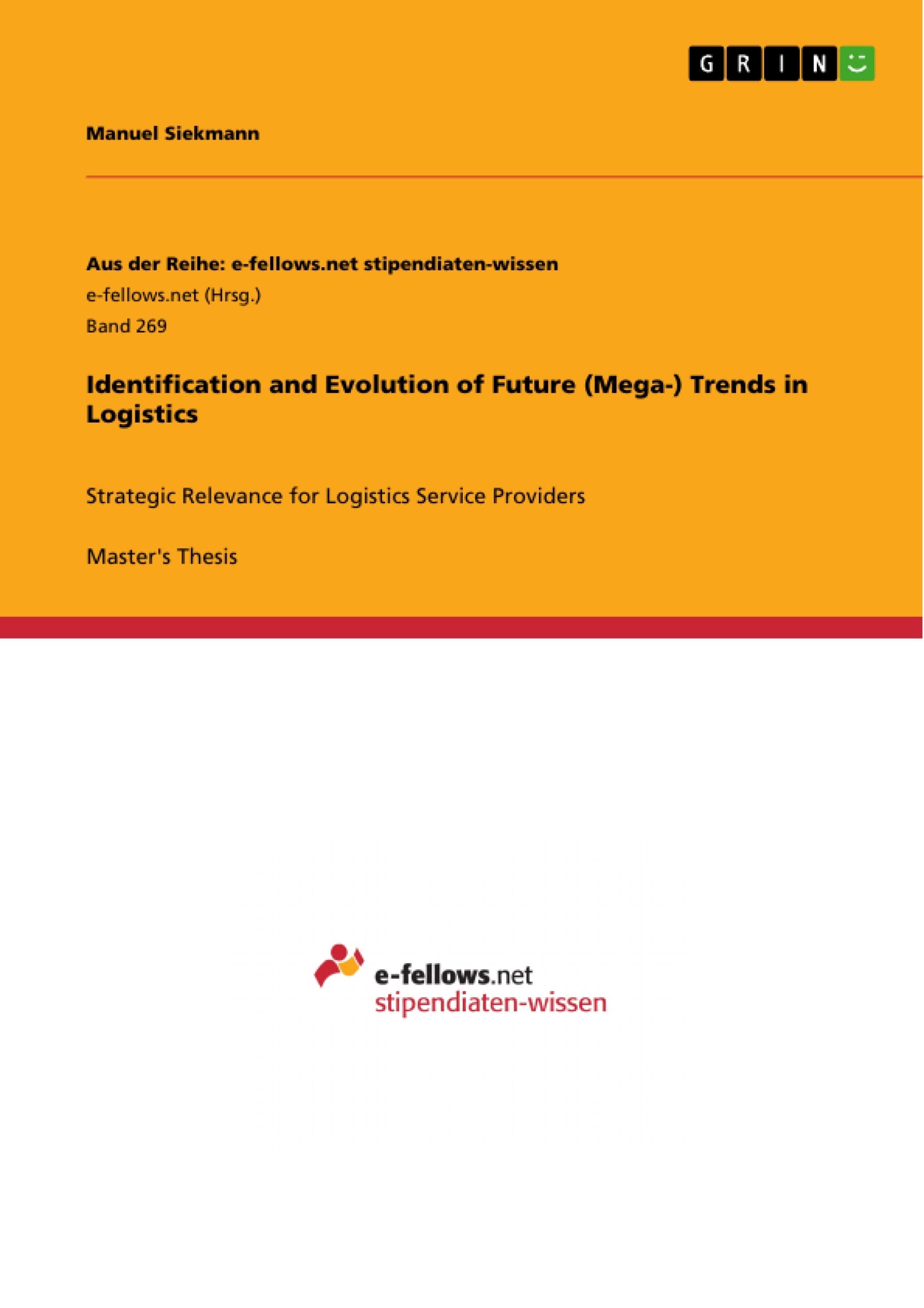The objective of this thesis is to get an overview of the status quo of logistics service providers' future orientation and their exposure to corporate foresight thinking and methodologies of futures studies as well as to identify specific future challenges in an attempt to comprehensively investigate how service providers prepare for upcoming challenges. An important managerial implication of the study is to create awareness among the participating companies of the potential of foresight and its various methods for applications in the ever more complex and rapidly changing logistics industry. The underlying assumption is that logistics service providers are heavily impacted by their external context. Moreover, foresight activities and methodologies are, in accordance with the title of the thesis, assumed to be of benefit for the identification and evolution of future trends and their corresponding strategic relevance. In line with the mentioned research goals, the benefits of this thesis are twofold: First, it contributes to the emerging discussion on foresight activities in corporations by adding
an industry-specific analysis. Second, this thesis can help draw the attention of decision-makers to the fact that foresight might become one of the most important sources of competitive advantage in tomorrow’s economy.
Inhaltsverzeichnis (Table of Contents)
- Introduction
- Research Problem and Objectives
- Course of the Investigation
- Foundations of Futures Studies
- Brief Historical Overview
- Classification of Terminologies
- Conceptual Foundations
- Fundamental Characteristics
- Relevant Methods
- Overview and Classification Schemes
- Scenario Technique
- Other Common Methods
- Futures Studies in a Corporate Context
- Motivation for Future Orientation of Companies
- Theoretical Foundations
- Review of Empirical Findings
- Logistics and the Logistics Industry
- Defining Logistics
- Theoretical Foundations of Outsourcing
- Classification of Logistics Service Providers
- Relevance of the German Logistics Market
- Review of Trend Studies
- Research Design and Methodology
- Research Context
- Survey Design
- Interview Design
- Framework for Analysis
- Research Findings: Future Orientation of Logistics Companies
- Characteristics of Participating Companies and Respondents
- External Impacts
- Orientation Toward the Future
- Information Gathering and Application of Methods
- Organizational Integration and Forms of Cooperation
- Strategic Relevance and Success Evaluation
- Obstacles and Counterarguments
- Future Outlook
- Specific Challenges for the Future
- Conclusion and Outlook
- Summary
- Theoretical Implications
- Managerial Implications
- Limitations of the Study and Suggestions for Further Research
Zielsetzung und Themenschwerpunkte (Objectives and Key Themes)
This thesis aims to identify and analyze future (mega-) trends in the logistics industry, focusing on their strategic relevance for logistics service providers. Through a comprehensive research approach, the author seeks to understand how logistics companies are incorporating future trends into their strategic planning and operations. The key themes explored in this work include:- The importance of futures studies for logistics companies
- The role of technology in shaping future trends
- The changing needs and expectations of customers in the logistics sector
- The strategic implications of globalization and emerging markets
- The challenges and opportunities presented by sustainability in logistics
Zusammenfassung der Kapitel (Chapter Summaries)
- The introduction establishes the research problem and objectives, outlining the scope and methodology of the investigation. It emphasizes the need for logistics companies to adopt a future-oriented approach in a rapidly changing environment.
- Chapter 2 provides a comprehensive overview of futures studies, including their historical development, conceptual foundations, and relevant methods. It explores various methodologies used to anticipate and analyze future trends, such as scenario planning and other forecasting techniques.
- Chapter 3 delves into the importance of future orientation for companies, examining the theoretical foundations and empirical evidence supporting the integration of futures studies into corporate strategy. It explores how companies can benefit from proactively considering future trends in their decision-making.
- Chapter 4 focuses on the logistics industry, defining logistics and exploring the theoretical foundations of outsourcing. It examines the various types of logistics service providers and highlights the significance of the German logistics market. The chapter concludes with a review of existing trend studies in the field.
- Chapter 5 outlines the research design and methodology employed in the study. It details the research context, survey design, interview design, and framework for analysis. This chapter lays the foundation for the data collection and interpretation presented in subsequent chapters.
- Chapter 6 presents the primary research findings, focusing on the future orientation of logistics companies. It analyzes the characteristics of participating companies, external impacts, and internal strategies related to future trends. It explores how logistics companies are adapting to changing market dynamics and integrating future trends into their operations.
Schlüsselwörter (Keywords)
The core concepts and key terms explored in this thesis include: futures studies, logistics, logistics service providers, future trends, strategic relevance, scenario planning, globalization, sustainability, technology, customer expectations, and the German logistics market. This work provides a comprehensive analysis of the relationship between future trends and strategic decision-making within the logistics industry, offering valuable insights for practitioners and researchers alike.- Citar trabajo
- Manuel Siekmann (Autor), 2009, Identification and Evolution of Future (Mega-) Trends in Logistics, Múnich, GRIN Verlag, https://www.grin.com/document/179004



